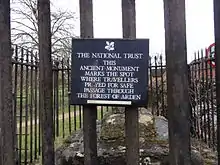Arden, Warwickshire
Arden is an area, located mainly in Warwickshire, England, and also part of Staffordshire and Worcestershire traditionally regarded as extending from the River Avon to the River Tame. It was once heavily wooded, giving rise to the name 'Forest of Arden'. It does not seem that the area was subject to forest law, however.
| Arden | |
|---|---|
 The Forest of Arden (1888–1897, possibly reworked 1908), Albert Pinkham Ryder. Oil on canvas, Metropolitan Museum of Art, New York City. | |
| Location | Warwickshire, United Kingdom |
History
Believed to be derived from a Brythonic word ardu- "high" (cf. Welsh: ardd), by extension "highland", the area was formerly thickly forested and known as the Forest of Arden. Located near the geographical centre of England, the Forest of Arden, through which no Roman roads were built, was bounded by the Roman roads Icknield Street, Watling Street, Fosse Way, and a prehistoric salt track leading from Droitwich.[1] It encompassed an area corresponding to the north-western half of the traditional county of Warwick, stretching from Stratford-on-Avon in the south to Tamworth (in Staffordshire) in the north, and included what are now the large cities of Birmingham and Coventry, in addition to areas that are still largely rural with numerous areas of woodland. The most important and largest settlement in the forest was the town Henley-in-Arden (in a valley of the River Alne, approximately 15 miles southeast of Birmingham), the site of an Iron Age hillfort.


An ancient mark stone known as "Coughton Cross" is still present at the south western corner of the forest, at the junction of Icknield Street (now A435) and the salt track. It is located at the southern end of the frontage of Coughton Court and is owned by the National Trust. According to local tradition, travellers prayed here for safe passage through the forest.
From around 1162, until the suppression of the order in 1312, the Knights Templar owned a preceptory at Temple Balsall in the middle of the Forest of Arden. The property then passed to the Knights Hospitaller, who held it until the Reformation during the 16th century.
Robert Catesby, leader of the Gunpowder Plot of 1605, was a native of Lapworth, a village in Arden. It is believed that many local families had resisted the Reformation and retained Catholic sympathies, possibly including the family of Shakespeare, whose paternal ancestors were from Temple Balsall.
Thorkell of Arden, a descendant of the ruling family of Mercia, was one of the few major English landowners who retained extensive properties after the Norman conquest, and his progeny, the Arden family, remained prominent in the area for centuries. Mary Arden, mother of William Shakespeare, was a member.[2]

Shakespeare's play As You Like It is set in the Forest of Arden, however it is an imaginary version incorporating elements from the Ardennes forest in Thomas Lodge's prose romance Rosalynde and the real forest (both as it was then, subjected to deforestation and enclosure, and the romanticized version of his youth).[3]
Towns in the area include Hampton-in-Arden, Henley-in-Arden, and Tanworth-in-Arden.
Proposal for a new national forest
The Countryside Commission considered creating a new national forest in the area in 1989, but the proposal was not taken up.[4] A national forest has since been established between Leicester and Swadlincote in the East Midlands, however.
Heart of England forest
Publisher Felix Dennis planted substantial areas of woodland in the area, known as the Heart of England Forest and on his death in 2014 left most of his fortune to be used for this purpose.[5] 3000 acres have been planted in Spernall, Dorsington and Honeybourne.[6]
References
Notes
- Webb 2008.
- Shapiro 2005, pp. 276–7.
- Shapiro 2005, pp. 270–4.
- The Forest of Arden, Heart of England blog
- Felix Dennis leaves £500 million fortune to his forest 24 June 2014
- Visitor information & directions
Sources
- Shapiro, James (2006). 1599: A Year in the Life of William Shakespeare. Faber and Faber. ISBN 0-571-21481-9.
- Webb, John (8 August 2008). "Forest of Arden". Heart-of-England. Archived from the original on 7 July 2011. Retrieved 3 February 2011.
Further reading
- Andrew Watkins. "Landowners and their Estates in the Forest of Arden in the Fifteenth Century" (PDF). Agricultural History Review. 45 (1): 18–33. JSTOR 40275129. Archived from the original (PDF) on 2007-09-27.